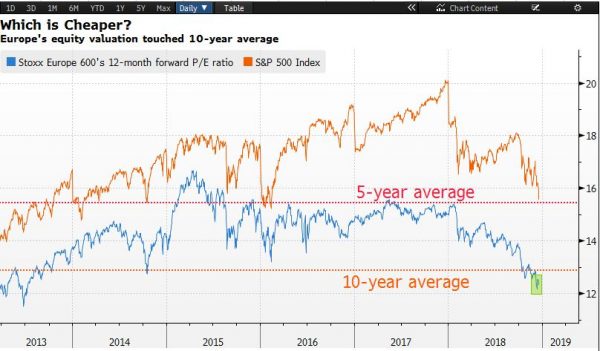Hopes of Santa Claus rally coming to town are dashed because the only powerful trend for the markets is the downtrend. The S&P500 is down nearly -4.78% YTD and the Dow Jones index has lost nearly -4.56% YTD. The situation is even worse when we look at the other side of the Atlantic, European markets are in the deep red territory. The Euro stoxx50 is down by 12.57%, the FTSE 100 index has plunged -11.80% and the DAX index is down by whopping -16.61%. So for the markets to experience the Santa Claus rally, it may as well peel off Santa from high street shops first.
What supported the markets so far was the robust U.S. economic data. However, the economic data has started to derail over in the U.S. The home builders sentiment number released yesterday fell to a level not seen since 2015. Remember, the housing data is widely considered as the leading indicator to measure the economic health of the country. The ongoing weakness in this area doesn’t paint an optimistic picture for the economy.
Of course, the weakness in this area is stimulated by the ongoing interest rate hikes by the Fed. The economy isn’t robust enough to stand the current pace of interest rate hikes, at least this is what the data is articulating. This week, the Fed is meeting again and it is widely expected that Jerome Powell, the Fed president will increase the interest rates again ignoring the economic health of the country or the markets. Basically, it seems like that the Fed has decided not to cave into any one’s will, doesn’t matter if it is the president of the United States or some market participants.
If we look at the equity markets, there isn’t anything positive there. To put things in perspective, the S&P 500 index is on track to record the second-worst December ever for the index. The S&P 500 index has touched its lowest level for the year and the current sell-off marks the worst annual decline since 2008. Clearly, bears are in strong control. Any upward move presents nothing but an opportunity for the sellers to join the current downtrend. Doesn’t matter if we are talking about the small cap of big cap stocks, the theme is the same..
Of course, the counter-argument is that the market is really cheap and the bulls usually step back in the market when stocks are cheap. The forward one-year price-earning ratio for the S&P 500 index has touched a level not seen since 2014 (close enough to kiss its five-year average) and for the European markets (EuroStoxx 600), this has plunged to a level not experienced since 2013 (dropped below its 10-year average).
Clearly, the European stocks present a lot more value for those who are into buying low and selling high. European shares are beaten down mainly due to the Brexit related political headlines and slowing economic growth in Italy has made matters worse.
As long as this hostage situation prevail, I think it may be just difficult to see any new trend emerging for the European markets. Thus, the European markets despite being cheap may still not become part of the shopping list for investors.














